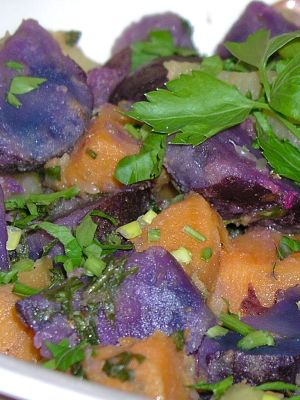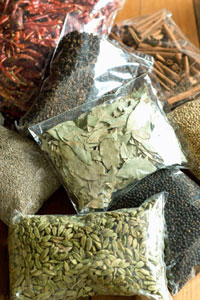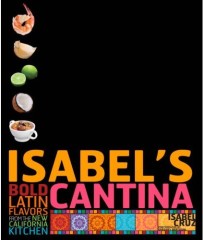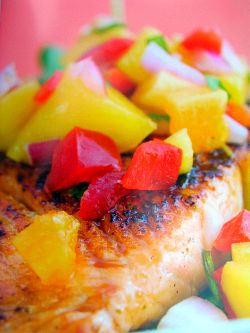No Small Potatoes
November 25th, 2007
Photograph by Skip Lombardi
University of Florida sports fans, like their large reptile mascots, never hibernate. Wildlife behaviorists confirm that Gators and their supporters are active year ’round, which means they need to eat.
While we eschew artificial food coloring, we admit to a fascination with fruits and vegetables whose unusual but natural hues might scare off the the bench-warmers and Junior Varsity.
Anthocyanins, responsible for the color of hydrangeas and red autumn leaves, also give the blues to foods like heirloom varieties of corn and potatoes. And though they’ve been available for years, in farmers’ markets and as blue potato chips, antioxidant-laden blue potatoes have not been promoted with the fervor of red wine and pomegranates.
It’s a mystery to us how Gators fans have overlooked blue potatoes’ potential to boost not only their immune systems but also the profile of pre-game provender. Pairing the orange carotinoids of sweet potatoes or yams with blue potatoes makes a salad guaranteed to light-up up any tailgate party, if not the entire parking-lot.
Cooks of the Gator Nation, flaunt your colors!
Gator-Tator ® Salad
Ingredients:
1 lb Small blue potatoes (about 4 potatoes)
1 lb Small red-skin potatoes (about 4 potatoes)
1 Medium sweet potato or yam (5-6 oz.)
2 Tablespoons olive oil
1 Lime (rind and juice)
3 Tbs coarsely chopped Italian flat-leaf parsley
1/2 tsp coarsely ground black pepper
1/4 tsp Salt
1 Scallion (including green top), finely chopped
Preparation:
Wash the potatoes and yam. Place in a 3 quart saucepan and fill with enough water to just cover them. Bring to a boil and reduce to simmer for about 10 minutes.
Test a potato with the point of a sharp paring knife. The potato should feel slightly harder at the center. Drain the potatoes and set aside until they are cool enough to handle.
Meanwhile, make the dressing. Rinse the lime; grate its rind and reserve. Juice the lime into a 2-quart non-reactive bowl. Add the olive oil, parsley, salt, and pepper to the bowl. (Start with this small amount of salt so as not to obscure the delicate flavor of the sweet potato.)
You may leave the blue potatoes in their skins, but for optimum color contrast, slip the skins from the sweet potato and red potatoes. Cut potatoes into 1-inch chunks and gently combine them in the bowl with the dressing.
Just before serving, gently stir the chopped scallion into the potatoes. Taste for salt.
Serves 4-6 (recipe may be scaled up)
Because we recognize that Gainesville and the far-flung communities of the Gator Nation are multicultural, we offer the following variations.
Gator-Tator ®Salad goes ethnic…
Use the recipe above as your guideline for:
Italian: Substitute lemon rind and juice for the lime. Add 2 Tbs capers and 1 small clove of minced garlic.
German: Omit the lime; substitute 2-3 Tbs cider vinegar. Add 2 strips of cooked, crumbled bacon, 1 medium onion ( sliced and sautéed), and 2-3 Tbs freshly snipped dill.)
French: Substitute lemon rind and juice for the lime. Add 1 Tbs prepared Dijon mustard. 2 tsp snipped fresh tarragon, 1 Tbs freshly snipped chives.
Greek / Middle Eastern: Substitute lemon rind and juice for the lime. Add 2 Tbs freshly snipped mint, 1/2 cup pitted olives, & 1/2 cup crumbled feta cheese)
Indian: In addition to the lime rind and juice, add 3/4 cup yogurt, 2 Tbs freshly grated ginger, 1 minced garlic clove, 1 seeded & minced green jalapeno pepper, 2 Tbs. coarsely chopped cilantro. Adjust salt.
Latino: In addition to the lime rind and juice, add 1 tsp toasted & ground cumin, 1 minced garlic clove 1 seeded & minced green jalapeno pepper, 2 Tbs coarsely chopped cilantro. Add Tabasco or other hot sauce to taste; adjust salt.
Floridian Fusion: In addition to the lime rind and juice, add 1 cup of seeded, halved tangerine slices, 1 tsp freshly ground allspice, and several dashes of hot sauce (Pickapeppa would be terrific!)
Celebrate diversity and invent your own!
[ad#bottom]
New Life for Fred’s
November 20th, 2007
We’re taking bets: Will the Porsche convertibles be parking curbside before or after Fred’s signature sidewalk tables reappear?
Denizens of Sarasota’s Southside neighborhood have been counting the days until Fred’s on Osprey reopens. The restaurant went dark in May of this year when the Epicurean Life Group put its holdings—Fred’s, Anabelle’s and Morton’s—up for sale.
Morton’s Market, repurchased by the original Morton family, recently held an open house and holiday tasting…the daily temperature is no longer above 90 F…lights on the cross-walk palm trees are illuminated…and now, there’s the very welcome sound of power tools and the smell of sawdust emanating from Fred’s.
The new management includes Sarasotan Jordan Leschert, himself a former manager at Fred’s, who has had considerable experience in front-of-the-house operations. (His uncle, Titus Leschert owns Café L’Europe on St. Armand’s and Café on the Bay on Longboat Key.) Patrick and Michelle Murphy, owners of seven restaurants in the Toronto area, are the other principals.
The new Fred’s will focus on steaks and seafood. According to Mr. Leschert, negotiations are ongoing with vendors who can deliver fresh, locally caught seafood, with the emphasis on local.
The executive chef will be Scott Kuhling, most recently of Fred’s Lakewood Ranch, and formerly sous-chef at Fred’s Southside.
Dale Mattern, who also returns to Sarasota from Fred’s Lakewood Ranch, will manage the day-to-day operations. He’s been in the restaurant business for more than twenty years and enthusiastically tells us that he’s assembled a top-flight, fun team to offer superb service.
With the change of cuisine, comes a change of goals for the restaurant. Mr. Mattern would like Fred’s to become a place where people feel as comfortable with an impromptu meal on a Tuesday night as they would for a special night-out on a Saturday. The team hopes that a little less fuss and more casual appointments will allow Fred’s to offer a menu of top-quality food at prices that make a weekday dinner an affordable treat.
Candles will light heavy wooden tabletops and booth seating areas. (One of the changes will be the elimination of white linens.) Mr. Mattern goes on to say that Fred’s will accept reservations, but that two-thirds of each night’s seating will be available to walk-ins, who (on crowded nights) will be given beepers. Patrons will be welcome to have a drink in the redesigned bar and lounge space, which will feature leather couches and chairs as well as stand-up ‘pub space,’ with newly-installed bracket shelves large enough to hold a pair of pints or martini glasses, and even an appetizer plate.
The bar will feature four imported beers on draft and a selection of martinis. A less rarefied wine list for both bar and restaurant will be offered. Appetizers will also be available at the bar, which will open at 3:00 p.m. daily. For patrons who like late lunches, Fred’s can still be an afternoon venue in which to see and be seen.
The new owners will reopen as ‘Fred’s Restaurant and Bar.’ The restaurant will retain the name ‘Fred’s,’ in part because of its iconic status in the community, and partly, as Mr. Mattern tells us, because the letter ‘F’ is set in mosiac tile in so many places throughout the building!
Though opening hours will be later, the new management will actually expand hours of operation. At this writing, plans are that the kitchen will be open until 10:00 p.m. Sunday through Thursday and until 11:00 p.m. on Friday and Saturday. The bar will be open until midnight Sunday through Thursday and until 1:00 a.m. on Friday and Saturday nights.
So, for those who toil at nearby Sarasota Memorial Hospital, there is the welcome prospect of a late-night draught and upscale bite at the end of the day. Mr. Mattern assures us that surgical scrubs and clogs will be welcome at Fred’s.
Management is aiming to open to the general public on December 10, 2007.
[ad#bottom]
An Indian-Fusion Thanksgiving
November 14th, 2007
Having recently published a review of American Masala by Suvir Saran, we were pleased to learn that Mr. Saran would be featured in the Celebrity Chef program at Apron’s Cooking School here in Sarasota. Lately, we’ve been writing about fusion food, and his Indian-fusion dishes in particular, but what really got our attention is that he’s doing some exciting things in American public schools.
So we thought we’d have a chance to chat with him between his book signing and demonstration dinner here at Apron’s. However, we arrived to find him and two Publix sous-chefs already well into food prep, patter, and pouring of wine because copies of his new book had not yet arrived from the publisher.
So, sometime after Thanksgiving, Chef Saran says he’ll be happy to have a long phone chat with us about his school programs. We look forward to that, because both in print and in person, we find Chef Saran a charismatic spokesperson for the civilizing effects of good food shared with family and friends. Like Alice Waters, whose Green Schoolyard program has addressed the spiritual and nutritional benefits of educating children about food, Mr. Saran is stepping into a realm where the rewards are not another Michelin star or effusive food magazine accolade. We’ll plan a future post about his activities.
Interview postponed, last evening, we stayed to share the demonstration meal with his audience—a slightly Indian-influenced Thanksgiving dinner: Sweet Pepper, Onion, and Chevre Bruschetta, Tamarind-Glazed Turkey with Corn Bread-Jalapeno Stuffing, Sweet Potato Chaat, Brussels Sprouts with Apples and Almonds, Sweet-Tart Cranberry Chutney, and Fig Flan. (All the recipes and the stories behind them appear in American Masala).
Mr. Saran fielded questions, discussed his background, suggested applications of Indian cooking techniques to non-Indian dishes, and voiced strong passions about food (and his fellow food celebrities). The two dozen class participants appeared to be thoroughly engaged and as nourished by Chef Saran’s own masala of personal history, gossip, and nutritional and political opinion as they were by his delightful meal.
For further information about Indian food and Chef Suvir Saran, see his Web site.
For information on Publix culinary programs, see the Apron’s Web site
Recipes from the Rim: Part III
November 8th, 2007
Isabel’s Cantina
Bold Latin Flavors from the
New California Kitchen
Isabel Cruz
Clarkson Potter (August 28, 2007);
224 pages; $27.00
In the introduction to her book, Isabel Cruz relates, “As a single mother with two kids to feed and no formal education to fall back on, I relied on what I knew best, the things I had learned in my childhood kitchen. Naively, I opened a restaurant in San Diego…”
Growing up in Los Angeles, the author’s Puerto Rican family loved to cook and party with their Peruvian, Mexican, Cuban, and Asian neighbors. One quickly realizes that Isabel Cruz had quite a lot to “fall back on.” Now a successful chef-owner of five West Coast restaurants, Ms. Cruz presents a series of bright and simple fusion recipes. She makes the most of California’s produce and ever more available fresh Asian and Mediterranean ingredients like ginger, lemongrass, mint, and basil. Balsamic vinegar, extra virgin olive oil, and soy sauce appear in Latin comfort food that has been lightened with creativity, common sense, and Asian dash.

Salmon with Papaya-Mango-Mint Salsa
Photo: Gregory Bertolini
Ms. Cruz’s restaurants have a wide spectrum of clients—those who go for the Power Breakfast plate of brown rice, steamed vegetables, scrambled egg-whites and get their kick from salsa and those who sink into the Pina Colada Pancakes. There are plenty of low-fat, and even some fat-free, recipes, but then there are Churros... (and yes, they’re fried, but in canola oil, not lard.) A make-me-right-now photo of guilt-free Raspberry-Lime Agua Fresca is balanced by a shot of Strawberry-Mango Cobbler. This is not spa food. Rather, it’s an array of beverages and dishes that, though born in restaurants, may be easily prepared by home cooks.
The food Ms. Cruz offers is both “healthy” and indulgent. She admits that she has tried to subtly slenderize both the recipes and those who love the food of Latin America. Lots of steamed, roasted, and grilled fish, poultry, and lean meat get their zing from quickly prepared sauces of citrus, chili, mint, and cilantro. But she doesn’t preach. Recipes include butter, sugar, white flour, and tequila as well as tofu, quinoa, collards, jicama, and chamomile tea. Rich or spare,the dishes are all appealing and speak for themselves; absolutely nothing in the book is self-concious. And in these days of fusion foolishness, Ms. Cruz’s food and philosophy should be welcomed into many kitchens.
Note: Clarkson Potter sent us this book for review



